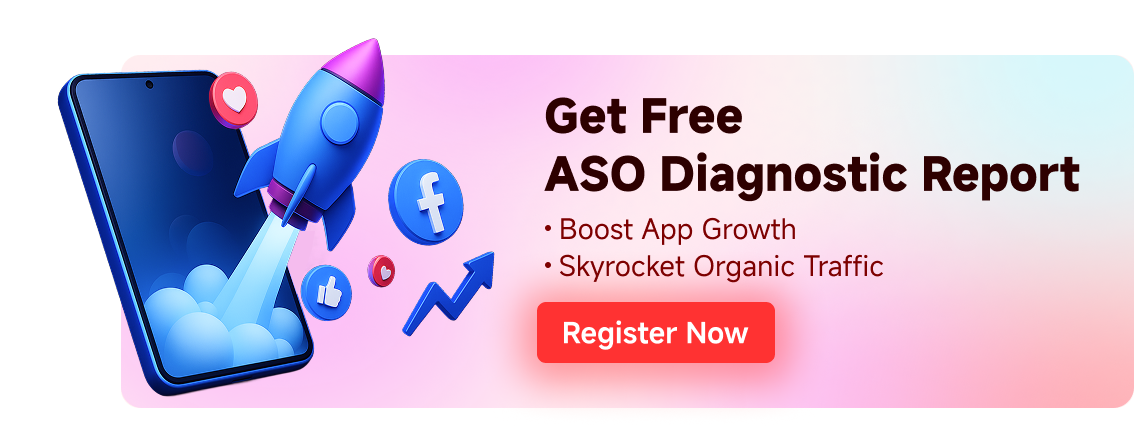Free consultation with ASO specialists
Doing ASO for the first time or have no idea how to carry out targeted optimization of your app?
We offer one-on-one customized services provided by app marketing specialists
Avoid 10 Deadly ASO Optimization Mistakes
2025-09-23
Introduction
As of 2025, the total number of apps in Apple's App Store and Google Play Store has exceeded 3.5 million, making competition fiercer than ever before. How can your carefully crafted app avoid getting lost among the vast sea of applications and be discovered and downloaded by your target users? The answer lies in App Store Optimization (ASO).
ASO, or App Store Optimization, is a set of strategies aimed at improving an app's visibility and conversion rates within app stores. Research showsAbout 70% of App Store visitors discover new apps through search, and 65% of downloads occur directly after a search.. This means that an excellent ASO strategy is the core engine for acquiring high-quality organic traffic.
However, many developers and marketers repeatedly hit roadblocks on the ASO journey, inadvertently making some critical mistakes that cause their app's visibility and download numbers to stagnate. This article will delve into the 10 most common ASO mistakes and provide practical solutions to help you avoid these pitfalls, enabling your app to stand out from the competition.
Mistake 1: Treating ASO as "hindsight is 20/20"
Many development teams firmly believe in "product is king," devoting all their energy to feature development and UI design, while treating marketing, especially ASO, as something to consider only after the app is launched. This is a shortsighted behavior with high costs.
Why is this a mistake? App stores (especially Apple's App Store) offer a short "exposure bonus period" for newly launched apps. During this time, the algorithm will conduct preliminary traffic distribution tests based on the metadata you provide (such as title and keywords). If you don't start planning your ASO from the very beginning, you'll be wasting this valuable, free launch opportunity. ASO is not a one-time sprint, but rather a long-term investment that spans the entire lifecycle of your app.
Solution:
Integrate ASO strategies into the early stages of product development. Consider keywords when determining the app name, and think about how to showcase its value through screenshots and descriptions when designing features. From Day 1, make ASO an integral part of your product growth strategy.
Mistake Two: Neglecting Keyword Research
"I think my users will search for these terms." — This intuition-based keyword selection method is one of the most common misconceptions in ASO. Guessing without data support is like shooting blindfolded; it's hard to hit the target.
Why is this a mistake?
You might end up choosing keywords with extremely low search volume that no one cares about, or diving headfirst into highly competitive popular keywords where you have no chance of success. Even worse, you could completely miss out on those "golden keywords" that can bring in a large number of high-intent users. The right keyword ranking strategy starts with precise research.
Solution:
-
Use professional ASO tools:Use the tool UPUP to analyze the search popularity, competition level, and relevance of keywords.
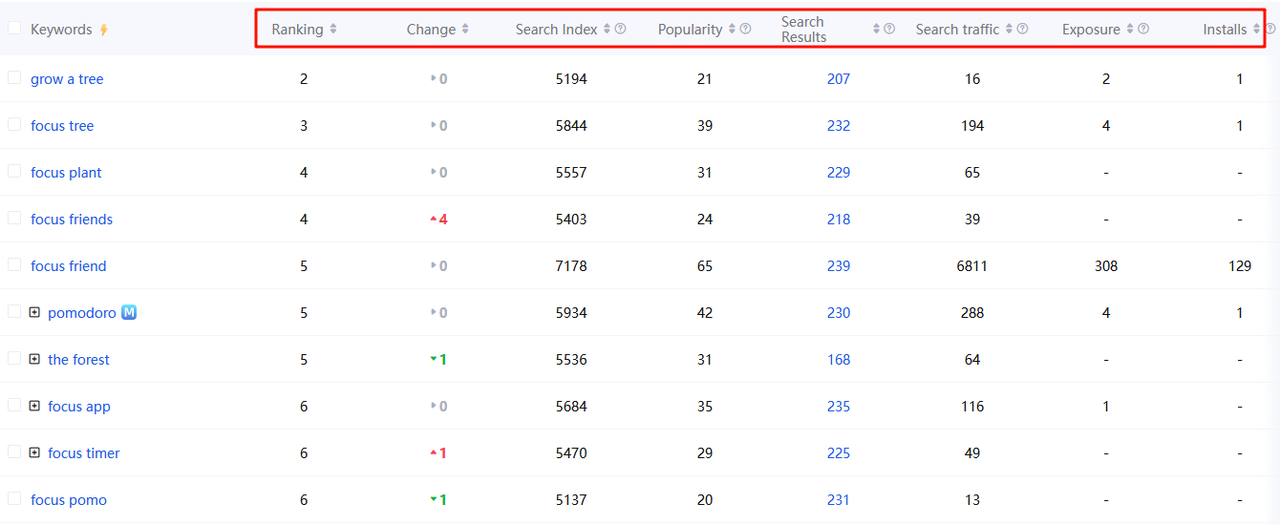
-
Analyze competitors:Check which keywords your top-ranking competitors are using; this can provide you with valuable inspiration.
-
Consider user intent:Think from the user's perspective: what words would they use to search for solutions when encountering problems? Long-tail keywords often lead to higher conversion rates.
Keyword research is the cornerstone of ASO, but doing it yourself can be time-consuming, labor-intensive, and prone to missing high-value terms. If you're unsure how to systematically build a keyword library for your app, we can help.Contact AppFast customer serviceYou can customize an exclusive one for your App for free.Keyword Library Scheme, covering core keywords and long-tail keywords to lay a solid foundation for your ASO journey.
Mistake Three: Insufficient Metadata Optimization
Even if you find the right keywords, their effectiveness will be greatly reduced if you fail to place them properly in key positions on your app store page. Metadata is the primary language through which you communicate with the app store algorithm.
Why is this a mistake?
The app store algorithms assign different weights to various metadata fields. The title, subtitle, and keyword fields are the most important factors influencing search rankings. Neglecting optimization in these areas is equivalent to giving up the most direct opportunity to improve rankings.
Solution:
-
App title/name:This is the area with the highest weight. Cleverly incorporate several core keywords after the brand name.
-
Subtitle (iOS) / Short description (Google Play):This is a supplement to the title, clearly summarizing the core functionality of the App in one sentence and naturally incorporating important keywords.
-
Keyword field (iOS):Apple provides a dedicated keyword field of 100 characters. Be sure to fill it completely, separating terms with commas and avoiding spaces or repetitions.
-
Long description (Google Play):Google will index the content in the long description. Here, you can provide a more detailed introduction to the features and strategically repeat the core keywords several times to enhance relevance.
Every character in metadata is crucial; improper optimization can waste valuable organic traffic opportunities. If you'd like to know whether there's room for improvement in your current metadata, feel free to use our free diagnostic service. Contact us now to receive a professional metadata optimization diagnostic report, clearly showing the potential for improving keyword rankings and download conversion rates.
Mistake Four: Keyword Stuffing and Abuse
The opposite extreme of under-optimization is "overdoing it." Some developers believe that stuffing as many keywords as possible into the title and description will improve rankings. This idea is long outdated and can have negative consequences.
Why is this a mistake?
Keyword stuffing not only annoys users and looks highly unprofessional, but also violates the app store's regulations.AppleAnd Google's algorithms are becoming increasingly intelligent, capable of identifying such cheating behaviors and potentially demoting your App. For example, Google Play explicitly prohibits the misuse of words like "first" and "free" in titles and descriptions.
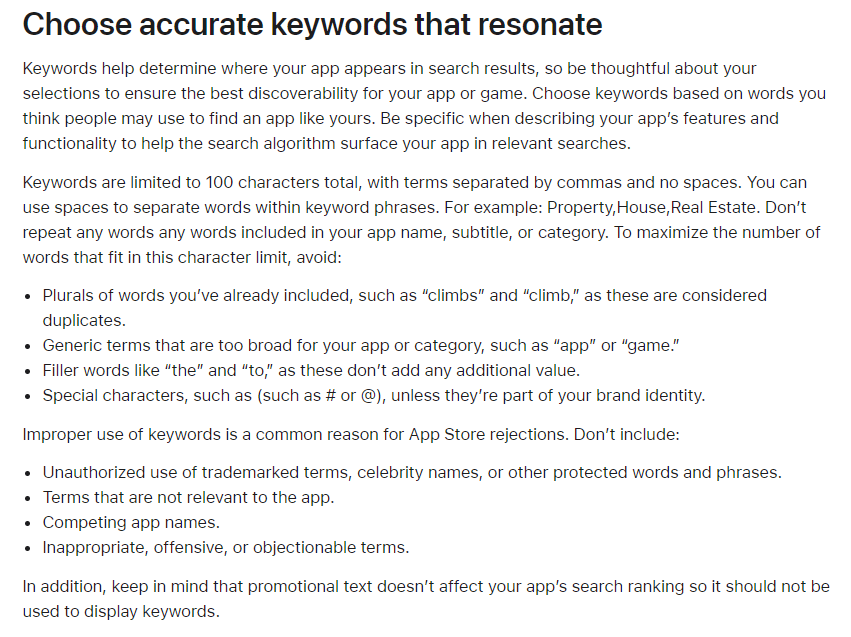
Solution:
Be user-centric. Your description is first and foremost written for people to read, and only secondarily for algorithms. Naturally and smoothly integrate keywords into compelling copy, allowing users to clearly understand the value of your app as they read, rather than being overwhelmed by a jumble of unrelated terms.
Mistake 5: Treating iOS and Android equally
To save time, many teams routinely copy and paste the App Store page information directly into Google Play. However, this "one-size-fits-all" strategy can severely impact performance on both platforms.
Why is this a mistake?
The App Store and Google Play are two distinctly different ecosystems, with significant differences in their algorithms, metadata fields, and user behaviors.
-
Metadata fields:iOS has a keyword field with 100 characters, while Google Play does not.But allows adding "Tags";The subtitle for iOS is 30 characters, while the short description for Google Play is 80 characters.
-
Algorithm logic:In iOS, repeating keywords in the title, subtitle, and keyword fields is ineffective; however, in Google Play's long description, moderately repeating core keywords helps enhance relevance.
-
Visual materials:The two platforms also have different requirements for the size and format of screenshots and videos.
Solution:
Tailor ASO strategies for each platform. Study keyword trends and competitive landscapes on both platforms separately, and optimize metadata and visual assets according to their respective rules and characteristics.
Mistake Six: Giving up the global market—ignoring localization
If your app has the potential to serve global users, providing only an English version will be a significant growth bottleneck. Localization is much more than just simple text translation.
Why is this a mistake?
By industryResearch, as many as 54% of App pages lack localization. This means they are voluntarily giving up a large user base that searches in their native language. On iOS, providing localized versions for different regions can even take advantage of "cross-localization," allowing you to be indexed by keywords in other languages, such as Spanish, in the U.S. region, greatly expanding your keyword coverage.
Solution:
-
Metadata localization:Translate and adapt your app's title, keywords, and description to the language and cultural norms of the target market.
-
Visual content localization:The text in screenshots, the UI interfaces displayed, and even the model images should all align with local culture.
-
Starting from the main markets:There's no need to rush. Start with the non-English markets where your app has the most potential, and gradually expand from there.
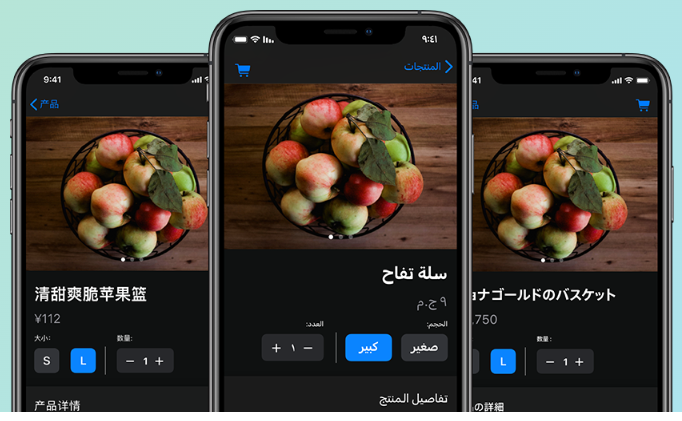
Mistake Seven: Ignoring the First Impression—Visual Material Optimization Failure
ASO is more than just a word game. When users find your app through search, the icon, screenshots, and preview video are key factors in determining whether they click "Download." This is the core aspect of conversion rate optimization.
Why is this a mistake?
Users are visual creatures; they will judge the quality of your app within seconds based on your visual materials. Blurry icons, disorganized screenshots, or simply a monotonous UI presentation can make users perceive your app as unprofessional and low-quality, prompting them to leave. The aforementioned industry study also pointed out that 56% of app screenshots fail to effectively convey product value.
Solution:
-
Create a unique icon:The icon is your brand's logo, which must be clearly distinguishable among numerous apps and convey the core functionality of the app.
-
Telling stories with screenshots:Don't just include a few raw UI screenshots. Instead, use design to string the screenshots together into a story, highlighting core features and user benefits. Add short, impactful captions or calls to action (CTAs) to the screenshots.
-
Create preview videos:If your app (such as a game or a complex tool) is difficult to fully showcase with static images, a concise 15-30 second video will be a powerful tool for boosting conversion rates.
Mistake eight: Acting on gut feeling—never conducting A/B tests
"I think this icon looks better." "The order of these screenshots should be fine." — Without data validation, these are all just assumptions. Many developers stop adjusting page elements after going live, missing out on numerous optimization opportunities.
Why is this a mistake?
The design you think is the best may not necessarily be the one users like the most. A tiny change, such as altering the background color of an icon, adjusting the order of screenshots, or modifying a single sentence in the description, can significantly impact conversion rates. Without conducting A/B testing, you'll never know which approach works best and will have to rely solely on guesswork, which is no different from sailing in the dark.
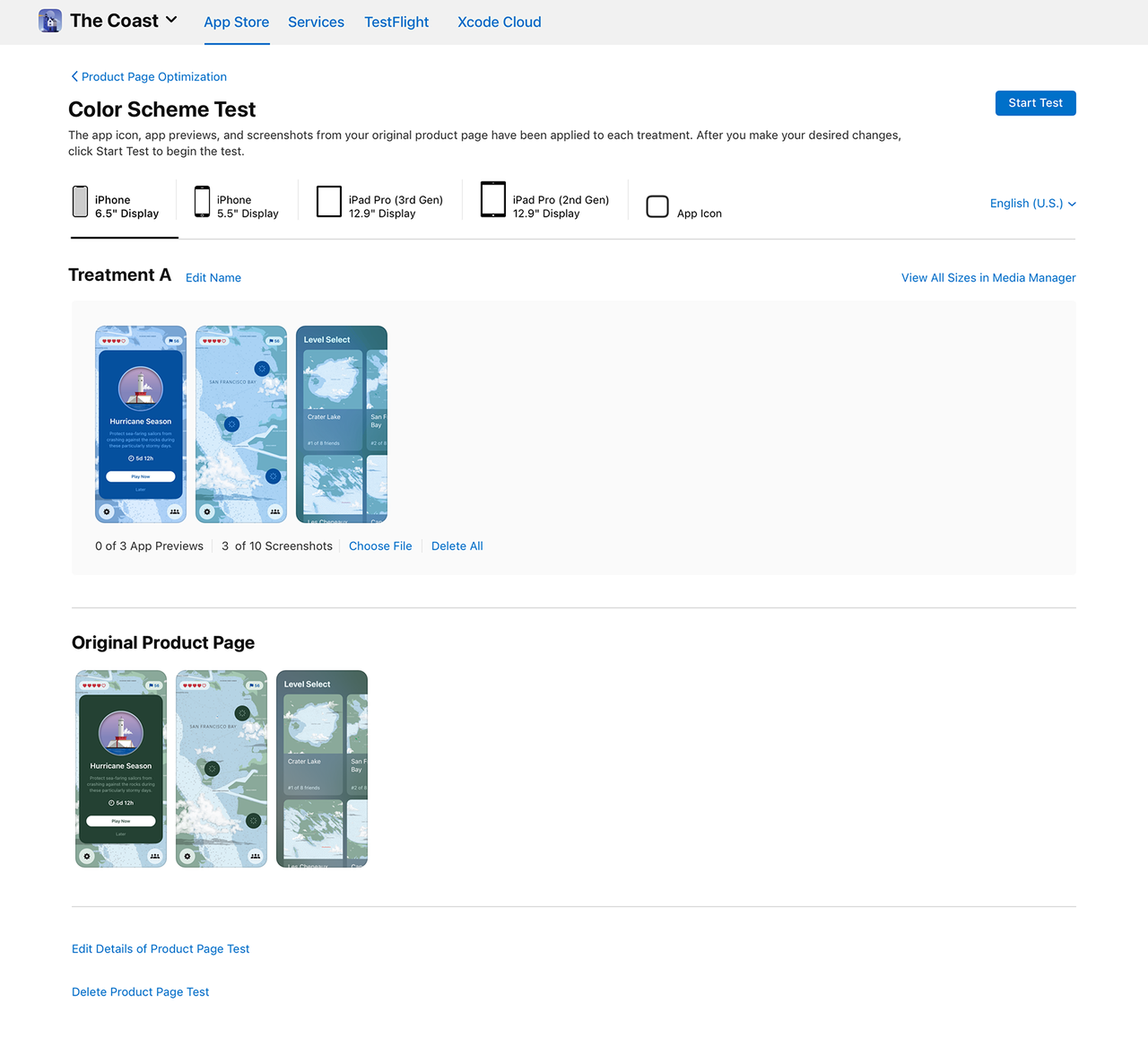
Solution:Systematically A/B test your app store page elements.
-
Test variables:You can test almost all page elements, such as icons, screenshots, preview videos, and short descriptions.
-
Using platform tools:Google Play Console has a powerful A/B testing feature built in ("Product Details Experiments"). For iOS, you can use its product page optimization feature or third-party tools.
-
Data-driven decision-making:Let the data tell you which approach can bring higher download volumes.
Mistake Nine: Ignoring User Feedback
Ratings and Reviews are the most prominent social proof on app store pages, yet many developers overlook managing this content.
Why is this a mistake?
-
Impact on rankings:App store algorithms treat high Ratings and positive Reviews interactions as signals of high App quality, thus assigning higher ranking weights.
-
Impact on conversion:Users will definitely check the Ratings and Reviews before downloading. A rating below 4 stars or a large number of unanswered negative Reviews will directly discourage potential users.
-
Missed Insights:Reviews are a free gold mine for understanding user pain points, discovering bugs, and gaining inspiration for new features.
Solution:
-
Proactively invite Ratings:At an appropriate time within the app (for example, after a user completes a task), politely encourage satisfied users to go to the store and leave Ratings.
-
Respond to all Reviews promptly:Especially negative Reviews. A sincere response can not only reassure users but also demonstrate your responsible attitude to other potential users.
-
Learn from Reviews:Regularly analyze user feedback and use it as an important basis for product iteration.
Negative Reviews and low Ratings are direct killers that drag down conversion rates, but manual handling is inefficient. We can provide you with a systematic approach toRatings and Reviews Optimization Management Service, helping you enhance your overall Ratings image in the app store and effectively boosting download conversions.Contact UsLearn more about strategies for optimizing negative Reviews and improving Ratings, turning social proof into your growth engine.
Mistake 10: One-time fix—lack of continuous maintenance
The last and most common mistake is thinking that ASO is a "done-and-finished" task. Many apps perform initial optimization when they launch, and then don't update for months or even years afterward.
Why is this a mistake?
The app market is constantly evolving. New competitors keep emerging, users' search habits are changing, and app store algorithms are continuously updated. Yesterday's best strategy may already be ineffective today. If your app store optimization strategy stagnates, your rankings and download numbers will only slowly decline, eventually being surpassed by competitors who actively optimize.
Solution:Treat ASO as an ongoing, cyclical process.
-
Regular monitoring:Check your keyword rankings, conversion rates, and the activities of your main competitors weekly or monthly.
-
Optimized with version updates:Each time you release a new version, it's a great opportunity to update your app store page. Update screenshots to showcase new features and adjust descriptions to highlight improvements.
-
Keep up with platform changes:Follow developer news from Apple and Google to stay updated on any changes in algorithms or policies, and make adjustments accordingly.
Are you wondering which keywords can bring the most downloads for your App? OurKeyword Ranking Improvement ServiceLeveraging advanced AI algorithms and manual optimization, we help your app achieve higher rankings for target keywords, enabling more potential users to discover your app.
Conclusion: ASO is an ongoing marathon
In the fiercely competitive app market, successful apps are invariably a combination of product strength and smart marketing strategies.App Store Optimization It is precisely the crucial bridge connecting these two. It's not a magic trick that happens overnight, but rather a science that requires patience, data, and continuous effort.
By systematically identifying and correcting the 10 common mistakes mentioned in this article—from strategic planning to detailed execution, from keyword research to user communication—you'll be able to build a powerful organic growth engine for your app. Start taking action now: audit your current ASO strategy, address your weaknesses, and ensure that your hard work is discovered, loved, and used by more users.
Related recommendations
